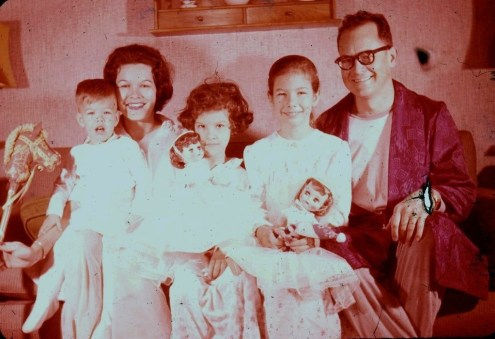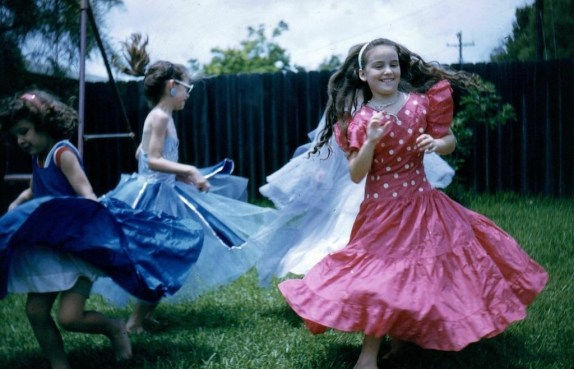
My sister Susan (left) and me, dressed for play.
I was blessed with a sister when I was only two years old. Susan became my everyday playmate, a kindred spirit who loved fantasy and story-telling and costumes—and whose imagination was attuned to my own.
When she was born, however, my parents were concerned that I would feel jealous of her. So, in keeping with the conventional wisdom of the day, they gave me my own baby doll (with a carriage!). They tell me I showed an initial joy when the doll appeared, but was more interested in my sister.
They gave me this doll when Susan was born, hoping I wouldn't notice my mother's baby was better.
Susan and I were never big on baby dolls, I must tell you, though we did have several of them (always the same toys, as well as matching clothes). The most popular doll of those early years was a creature called “Tiny Tears,” who had a hole in her mouth where you could insert a little bottle full of water. The water then might come out through holes in her tear ducts or one in her rear end. This capability was interesting for a little while. I have a clear memory of taking our naked Tiny Tears out to the back yard and putting tiny seeds from one of the trees down the hole in their mouths. Then we shook them and squeezed their bodies until the seeds blew out their butts. That was the most fun we ever had with them.
The “little girl doll,” supposed to be a playmate to its owner, was an invention of the mid-century. A popular one was the Betsy McCall doll, named after the paper doll in each issue of McCall’smagazine at the time. Both baby dolls and little girl dolls were considered “safe” for Boomer girls to play with.

Christmas morning, 1959. These were "Betsy McCall" dolls. My mother made elaborate wardrobes for them, trying to distract us from wanting Barbies (The clothes were gorgeous, but the ruse didn't work.) My brother got a stick horse. He must have had hundreds of them because they appear in pictures from every gift occasion of his childhood.
Before the invention of Barbie, who appeared like a cultural thunderstorm in 1959, our favorite game was dress up. My mother would give us cast off hats, jewelry, and clothing we used for long hours of fantasy play. My grandmother kept a huge closet upstairs with beautiful old clothes. Even formal dresses! All the cousins would go upstairs and put on clothes for stories we would collectively imagine and act out.

My little brother with his gender-appropriate toy and his gender-appropriate fire engine pajamas.
My brother also appeared in 1959. Susan and I were thrilled with him. But in the all-female environment of our daily lives—cousins, sisters, aunts, mother, grandmother—he was an anomaly. The adults made clear to him at every moment that playing with girls, especially their dolls and dress-up, was an indignity. Poor thing—what was he to do? I can remember trying to devise appropriately masculine costumes and roles for him, to keep him from crying at the tension my father and the other men created when they happened to catch him playing with us. But I also remember that we ourselves were cruel, treating him as “Other,” and, I think, often taking out on him the budding realization that, outside our little playworld, the males held all the power. Within our playscape, however, he was definitely the saddest victim of the Feminine Mystique ideology. When GI Joe finally appeared, it was like a gift from God. Now it was OK for my brother to play with us.
One gender neutral activity we loved was coloring. We sometimes used coloring books, but more often we were given a piece off an inexhaustible roll of butcher paper on which to create our works. We were very competitive with each other about our art. And, indeed, Susan grew up to be an artist and designer. (My sister now makes materials and tools that allow others to be creative. She goes by “Yardwork” online and her things are quite popular). But I do remember that many of those hours were focused on producing our own paper dolls with their own clothes, something at which we eventually excelled.

I think it significant that, though Barbie was unquestionably our favorite and most important toy, there are no photos of us with her.
I have written at length about the appearance of Barbie in my book, Fresh Lipstick. I read this passage aloud once at a book signing and the audience laughed til they cried. So I feel I hit a nerve. My argument is that owning a Barbie was, for most of us, an act of defiance, a gesture against the Feminine Mystique ideology that tried to ram baby dolls and play kitchens down our collective throats.
People have forgotten (or are too young to know) what the 1959 Barbie was really like. She was incredibly slutty-looking and even children knew it. Not just the boobs, which were enough to cause a row in every 1950s family, but the dangly earrings and that naughty eyeliner. Mothers everywhere hated her—even the Mattel people knew that. The resistance to buying her was very strong. Later, the feminists who wrote about Barbie said their mothers forced the doll on them. I can’t tell you how much of an outlier that tale is.
Barbie was young and single and, unlike our mothers, she worked. She had costumes that were made after the latest fashions and beautifully crafted with real zippers, labels, fur, and feathers. The 1959 Barbie would not have been caught dead wearing the sleazy shards of cloth Mattel puts their dolls in now.
“Playing Barbies” thus presented possibilities we had never had before. It was like dress-up or paper dolls, only with better clothes and props. Our imaginations could run as wild with this doll as they did with my grandmother’s costumes—we were not confined to a motherhood preparation scenario, as we were with other dolls.

Susan, me, and my cousin, Duellen, having a great time in her sister's cast-off majorette outfits.
But, make no mistake, little girls played games with Barbie that, in the ethos of the mid-century, were sexual. Susan and I played out stories that were much like the romantic comedies we loved. In this respect, our play was consistent with the Feminine Mystique. But we also played our Barbies as astronauts and witches and fairies and murderers. I can’t emphasize enough that we never played the Barbies having children or going to the PTA. Nor did any other child I knew. Instead, we used Barbie as a vehicle to let our imaginations fly. She was the avatar for a world my sister and I collectively created and directed. Indeed, I think it is a really important lesson to bear in mind: those radical young women who carried forward the Second Wave were the same little girls who played with Barbie. So, equating the form of the toy with the import of the play is superficial thinking.

Kathy playing with a variation on Chatty Cathy, a character from a cartoon called "Beaney and Cecil," which also had the pullring from the neck.
One “little girl doll” bears mentioning. Chatty Cathy had a ring in the back of her neck that you could pull and she would “speak” a random selection of recorded messages. We didn’t have her. Instead, years later, we would joke that we had our own Chatty Kathy: my youngest sister, who was born in 1961 and, once she learned, never stopped talking. However, the last dolls Susan and I had were technology dolls of this order. Susan’s was Charmin’ Chatty, who actually had records that slid into her back to be played. Mine was Puppetrina, whose arms and legs could be moved from within. They lasted about half an hour before we were bored with them.
Susan with Charmin' Chatty. This doll was very cool-looking, in our opinion, regardless of her other talents.
After that, the only dolls we had were of the “collectible” variety, especially the Madame Alexander series of Little Women. These dolls were gorgeous, but you couldn’t play with them because you had to keep their hair nice. Dolls that sit on a whatnot shelf don’t earn their keep, if you ask me.
Looking back now, I can see that there was a strong ideology to the array of toys we saw as children. The baby dolls and little girl dolls, especially, seem like the kind of toy that isn’t much to play with, but made the grownups happy. In the end, however, our play was imaginative story-telling that, to some degree, was independent of the actual objects in use. And though you can certainly see the origins of careers and personalities in the kinds of toys we loved best, these objects in themselves are not enough to explain who we became.
The story of the Feminine Mystique is really my mother’s story, however. To read that, click here.

That's me on the right. Susan not looking at all happy on the left.







Comments